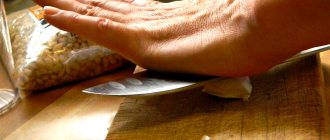The skin on the tomato remains dense even after heat treatment of the vegetable, which is not very pleasant when eating the dish. It gets stuck between the teeth, sticks to the roof of the mouth and spoils the appetite with its presence, so it is wise to get rid of the skin of the tomato before cooking it.
There are several ways to remove the peel, that is, blanch tomatoes without much effort, without damaging the pulp. The most effective of them are described in our article with a visual video.
Advice: to make it easier to remove the skin from a tomato, the main condition is to first make a shallow cross-shaped cut on the side opposite to the cutting.
How to easily and quickly peel tomatoes in boiling water, how to scald tomatoes correctly?
It is worth peeling the thin skins of tomatoes before adding them to soups, stews, or to create various sauces. This is necessary because, at a minimum, the skin of a tomato is poorly absorbed by the body; it is especially worth excluding this product from the diet of children or the elderly. And also, in terms of the appearance of the dish as a whole. When cooked at high temperatures, the skin of the tomato peels off and does not look very appetizing.
Cross cuts
You can remove the skin from a tomato in various ways, and the most common method is using boiling water. To do this you need:
- Heat water to 100°C
- Make a cross-shaped cut at the base of the tomato.
- Place the chopped vegetables in a deep saucepan
- Fill with boiling water completely
- Leave for 30 seconds.
- When the skin begins to curl, you need to fill the tomatoes with purified cold water, you can even add a few ice cubes. You can also simply place the tomatoes under running water. This process will not allow the tomatoes to cook, but all the vitamins will be preserved.
- After the vegetables have cooled, remove the skins, starting from the cut ends, using the blunt side of a knife.
Of course, there are cases when the skin is difficult to remove, for example, when the tomato is young. To do this, you need to repeat the procedure, while immersing it in boiling water for only 15 seconds. The main thing is not to let the tomatoes sit in boiling water for more than 1 minute, because... The cooking process will begin and the structure of the vegetable may change. Also, for greater confidence in an effective result, you can make cross-shaped cuts on the two poles of the tomato.
Using peeled tomatoes
It’s nice to eat vegetables without skin, especially since there is a category of dishes in which the skin will not only spoil the appearance, but also the taste of the dish. For borscht, lecho, various preserves, and stews, it is necessary to peel tomatoes.
Let's look at several recipes that require tomato peeling.
Peeled tomatoes in their own juice
Ingredients:
- 300 g tomatoes;
- ½ tsp. salt;
- 1 tbsp. granulated sugar;
- 5 black peppercorns;
- citric acid to taste.
Preparation:
- Place granulated sugar, salt, and citric acid in a jar.
- Peel the tomatoes and put them in a jar.
- Heat the water for sterilization and place the jar in it.
- Boil, periodically add tomatoes to the jar when they settle.
- Sterilize the jars for 15 minutes after they are completely filled with juice.
- Roll up and put in the pantry.
This is an excellent side dish for potato dishes.
Important! For canning, use only rock salt - iodized salt is not suitable for canning.
Vegetable stew
Ingredients:
- 2 potatoes;
- 1 bell pepper;
- 2 tomatoes;
- 0.5 pcs. zucchini;
- 1 onion;
- 1 tbsp. tomato paste;
- frying oil;
- salt to taste.
Preparation:
- Peel and cut the vegetables.
- Blanch the tomatoes and remove seeds.
- Fry carrots and onions in oil.
- Add tomato and zucchini.
- Add salt, add water, simmer for 7 minutes.
- Add the rest of the vegetables and tomato paste.
- Add water to cover all products.
- Simmer over low heat for 40 minutes.
Cherry tomato sauce
A great addition to spaghetti and potato casseroles.
Ingredients:
- 20 cherry tomatoes;
- 2 cloves of garlic;
- 15 basil leaves;
- 2 tbsp. olive oil;
- spices to taste.
Preparation:
- Coarsely chop the garlic.
- Heat a frying pan, add oil and add garlic.
- Scald the tomatoes with boiling water, remove the skins and place in a frying pan.
- Simmer over low heat for 30 minutes.
- Add basil and spices to taste.
- Cover with a lid for 3 minutes. Finally, remove the garlic from the sauce.
Can be served both cold and hot.
How to easily and quickly peel tomatoes using the microwave?
One of the modern methods of peeling tomatoes is cleaning using a microwave oven. This method is perhaps the fastest of all; to carry it out you need:
- Rinse the product under running cold water
- Dry well using dry towels or napkins
- Make small cuts, in this case, not only on the poles of the tomato, but also longitudinal cuts on the sides of the vegetable
- Use a plate with a flat, level bottom. Place tomatoes on it and place in microwave
- Heat vegetables for 30 seconds, depending on the power of the electrical appliance, you can heat them up to 40 seconds.
- The peel simply begins to curl up and separate from the fruit on its own; all that remains is to peel off the shreds.
Clean in the microwave
These methods, although characterized by relatively quick results, in turn have a negative side, because... it is necessary to strictly adhere to the permissible time frame, and the procedure cannot be repeated. This can significantly affect the pulp of the vegetable, which begins to collapse after overheating, and also, the tomato may leak juice or burn. If you are unable to get rid of the peel the first time, you need to start peeling it manually using a dull knife.
Using tomato skins in decorative dishes
Using tomato peels you can quickly and easily decorate almost any dish. More “meaty” varieties are best suited for this, as they add the necessary volume when decorated. To make, for example, a decoration in the form of a pretty rose, you need to use a very sharp knife to start cutting off the skin with a small layer of pulp from the end of the tomato opposite the base. Moving in a spiral and maintaining a uniform width, you need to remove the peel from the entire surface of the tomato, ending with a cut near the stem. Keep in mind that the thinner the strip, the better it will wrap.
How to easily and quickly peel tomatoes by blanching?
Blanching is a thermal method of processing food products, caused by short-term exposure to boiling water or steam. Thanks to this method:
- Can preserve the color of vegetables and fruits
- Remove bitterness or specific odor from a product
- Remove the skin from the tomatoes without destroying the pulp of the vegetable.
This process is very similar and the dough is related to the peeling method using boiling water. The technology of the process itself is as simple as with the boiling water treatment method:
- Prepare a pan of boiling water and a container of ice water
- In the area of the stalk you need to make an incision in the form of a cross.
- Place the tomatoes in a colander and place in a pan of boiling water.
- After 30 seconds, remove the vegetables and place them in a saucepan with cold water for literally 5 seconds.
- Peel the skin immediately after blanching while the tomato is still warm
Blanching
The procedure for scalding a tomato with steam is the same, only you need to pour less boiling water into the pan, and the scalding process takes a little longer. This method is considered one of the most useful, because... After processing, tomatoes retain all their beneficial substances and nutritional properties. The vegetable perfectly retains its pulp structure after using this method, so in the future you can use the product for preparing salads or cold soups, baby food, etc. With this cleaning method, the tomatoes come out much neater than with others, especially if you scald the product with steam.
Criteria for choosing a cleaning method
You should consider just a few nuances to choose the method specifically for your case.
Quantity, maturity and purpose of cleaning matter when choosing a cleaning method
- Maturity . The skin of unripe tomatoes is more difficult to remove, so not every method will be suitable, but overripe ones are much easier to peel.
- Purpose of skinning . Some recipes require maintaining the shape, which requires some type of peeling or cutting.
- Quantity . If there are more than one kilogram of tomatoes, then heat treatment in batches is the best option. The number of tomatoes depends on the size of your pan.
How to easily and quickly remove the skin from a tomato by baking?
Most chefs prefer the method of peeling tomatoes by baking. This method is considered the most “gentle” for vegetables and fruits:
- First you need to preheat the oven to 180°C
- Wash and dry the fruits thoroughly
- Make cuts at the base
- Place in the oven for literally 2-3 minutes.
- While the vegetable is still hot, you need to carefully remove the dried peel from the fruit; this action is performed with the blunt end of a knife.
Remove the skin from baked tomatoes
. Using this method, you can also prepare stuffed tomatoes and peel them just before serving. The aroma and color of the fruit becomes brighter and richer than after using other methods. It is worth emphasizing that thanks to this method, all nutrients and beneficial substances are preserved in the product, thus the baking method is equal to the blanching method.
When baking, you don’t have to worry about the juice leaking out or the texture of the product deteriorating. This method is suitable not only for tomatoes, but also for peeling many other vegetables and fruits, for example, bell peppers, beets, etc.
Knife
The most labor-intensive, but does not require additional equipment, method.
- Wash and dry the tomatoes, cut into quarters.
- Carefully place the knife at the junction of the pulp and the skin and cut it off with a knife. Take care of your hands!
This method is suitable for those cases when, in addition to the skin, you also need to peel the tomato from the seeds.
An alternative option is a vegetable peeler. But it is convenient to work only with dense and not overripe tomatoes.
The tender pulp of a tomato without skin is an excellent ingredient that is a pleasure to work with. Here are a couple of wonderful recipes.
How to easily and quickly separate the skin from a tomato with a knife?
The least common method is to use a knife to remove the skin. This is justified by the fact that this method is most suitable for ripe tomato fruits, or if after heat treatment the product begins to taste a little bitter, and this can completely ruin the taste of the intended dish.
The method of peeling tomatoes with a kitchen knife belongs to the “cold” cleaning methods, and therefore is quite useful for the body, because the product is not exposed to high temperatures and does not lose its properties.
Of course, for cleaning, you can purchase a special knife for peeling vegetables, with its help it is very easy to separate the peel from the pulp. If this is not the case, you can use any kitchen knife, having first sharpened it well. However, when using ordinary vegetable peelers, there is a risk that the tomato may release juice, because... Along with the peel, part of the pulp is also removed.
Cleaning vegetables and fruits
Before using a knife to peel a tomato, you need to remember some rules:
- First, wash and dry the fruits.
- If the tomato is ripe, then removing the skin is not difficult; you must first make cuts at the base, and even begin the peeling process. If the peel does not come off, it needs to be trimmed slightly.
- For unripe tomatoes, a slightly different technique is suitable: to do this, you need to divide the vegetable into 4 slices, then place one part skin down and cut off the pulp using a very sharp tool. This method is only suitable if chopped tomatoes are included in the recipe. For example, when preparing “Caesar”, “Greek” and other salads and appetizers.
- When working with large tomato fruits, you need to make several thin cuts not only on the poles of the tomato, but throughout its entire surface. It is important to do this with a hot knife, and to use a cold one for cleaning itself. This process may take some time, but you will be pleased with the results.
It is worth remembering that this technique is completely unsuitable for dense and unripe fruits, because Pieces of pulp may come off along with the peel, which can significantly spoil the appearance of the fruit.
How to choose seeds
Tomato seeds are removed because they are bitter, get stuck in the teeth, or are not recommended in the recipe. Cherries are cut in half and the pulp is scooped out with a teaspoon. A small elongated fruit is cut into 4 parts, a large and round one is cut into more parts. The main thing is that the surface of the slices has a flatter shape. Place the slice with the flesh side up and use a knife to separate the skin, pressing it to the table. The knife blade is held almost parallel to the table surface.
Peeling tomatoes is not a whim. Naked tomatoes are not only ideal for some dishes. They can be given to children without fear.
- Author: Tina Bliznyuk
Rate this article:
- 5
- 4
- 3
- 2
- 1
(0 votes, average: 0 out of 5)
Share with your friends!
Why peel tomatoes?
- Remove the stem and use a sharp knife to make cuts from it to the opposite side. Depending on the size of the tomato, make 4 to 6 cuts, being careful not to catch the flesh.
- Place the tomatoes on a plate and microwave for 30 seconds, setting the power to about 600 W.
- After the end of the program, cool slightly and remove the skin.
Boil the pasta in salted water until done. Remove the skin from the tomatoes using a convenient method and cut the pulp into small cubes. Combine the finished pasta with tomatoes, grated cheese and mix. Add herbs and spices to taste.
Purpose and principle of operation
How to properly tie tomatoes in open ground
We are talking about a monocular with mounts for mounting on a gun. Despite the simplicity of the design, it must meet certain standards and requirements: the strength of the sight is important, because during the firing process significant shock loads arise, which the design must withstand. Therefore, when choosing, you should take into account the recoil force of the gun on which the device will be installed.
The operation of NVDs is based on the principles of optics and elementary physics. The device consists of 3 main parts:
- eyepiece;
- lens;
- The image intensifier is an electron-optical converter.
It's no secret that the illumination of the area at night is significantly worse compared to the day. The light sources in this case are street lamps, the moon and, to some extent, stars.
A modern night vision scope significantly improves hunting and the quality of hits
The operating principle of a night vision device is very simple. Light reflected from objects is captured by the object. Naturally, we are talking about a small amount of light, but it is quite enough to obtain a picture of good quality.
The signals received by the sight are processed by an electron-optical converter, which amplifies them several times. Some models are capable of amplifying the signal several tens of thousands of times. After processing, the image appears in the eyepiece, becoming visible to the shooter.
Signal processing most often occurs in black and white with accents on some shades. Most modern scopes feature green tones. This is explained by the fact that they are clearly visible to the human eye.
Most modern models of night vision scopes for hunting are additionally equipped with an infrared lamp. Such a device is used in extremely poor lighting conditions (for example, if the sky is overcast and the light level is very low). The main advantage of infrared radiation is the fact that it is not perceived by the human eye and is not capable of scaring away animals. However, it turns out to be more than enough to identify the object of observation. Even if you use such a sight in pitch darkness, it shows excellent results.
Generations of night vision scopes
The weight of the PNS 3×50 night vision sight is about 1 kg. There are three generations of night vision sights on the modern market:
- Generation I. They are affordable, but have very limited capabilities. The main disadvantages of such devices are a blurred image at the edges of the picture and high sensitivity to flare. The latter makes it impossible to shoot near light sources (fire, flashlight or headlights, etc.). To work comfortably with such devices, the use of high-power infrared illuminators is simply necessary. Special mention should be made about generation I+ sights. These are modified models with increased resolution and protection against flare, which allows you to get a clearer image. Naturally, their price will be slightly higher than conventional first-generation sights, but such an overpayment is more than justified.
- Generation II. Such devices are more advanced: they have a good range and are characterized by a clearer picture in low light (users note good visibility even on a moonless night). The second generation of NVDs has light amplification up to 35 thousand times. The use of infrared illuminators when hunting gives excellent results, since these devices are highly sensitive to infrared rays. Many novice hunters, after purchasing first-generation optics, soon replaced them with second-generation designs.
- Generation III. Such night vision devices are equipped with special photocathodes, which are made on the basis of gallium arsenide. Even at high magnification (more than 5X) and in conditions of almost complete absence of lighting, they produce excellent detailed images. At the moment, such devices are considered the most advanced in technical terms. The only drawback is their high cost.
Second generation scopes are the most popular among hunters. Such devices are a kind of golden mean between low-functional 1st generation night vision sights and expensive 3rd generation devices.
Thick tomato soup with feta
This simple recipe will perfectly diversify your usual first courses.
- Tomatoes – 700-800 g (in winter you can use canned ones in their own juice);
- Onion – 1 pc.;
- Garlic – 1-3 cloves;
- Vegetable oil – 50 ml;
- Sugar – 1 tsp;
- Feta – 100-120 g;
- Salt and spices to taste.
Adviсe
With any method, it is important to carry out the procedure correctly
It is often advised to remove existing seed material. To remove seeds, peeled tomatoes are cut into thin slices
Then carefully remove the seeds. The tomatoes are rinsed again after the procedure. The simplest and fastest methods are based on minimal heat treatment
This is due to the fact that the skin peels off more easily after exposure to high temperatures. These tips are useful if you plan to cook marinated dishes, stew or boil side dishes. Fresh vegetables are often eaten with the skin (if it is thin).
Proper peeling of tomatoes is important when preparing most dishes.
Tomatoes are a popular vegetable that is often used in culinary recipes.
Depending on the cooking method, it is important to process them correctly. It’s not difficult to deal with options such as washing, cutting, removing seeds.
However, not everyone knows how to peel a tomato.
Why peel tomatoes?
In many recipes it is written: “Tomato pulp is required,” the reason is not that the cook is meticulous. Incomparable taste, excellent piquancy and weightless acidity - this is what a tomato gives to any dish in which it ends up. In order not to lose these gifts, the first thing you need to do is remove the skin before cooking, as it makes the taste of the dish bitter .
In addition to the above, the properties of the skin are not entirely beneficial for the body. We'll tell you why below.
Another reason is preference . Not everyone likes to find bundles of peel in their plate, try to remove it from the roof of their mouth with their tongue when eating soup, or even when the skin gets stuck between their teeth, so peeled tomatoes are a great option to avoid such problems.
Most importantly, heat treatment with the hope that the skin will lose its density is useless, so it’s worth knowing about several techniques for peeling a red fruit and choosing the one you like the most.
Fire treatment
Peeling tomatoes is easy if you preheat them over an open fire with a gas burner. The procedure includes the following:
- the remains of the cuttings are removed;
- a cross-shaped incision is made on the opposite side;
- the gas burner is turned on at the maximum possible power;
- Using metal tongs, hold the product above the fire at a distance of 3 cm, slowly turning it for up to 30 s until the skin darkens.
The heated tomato is cooled, for which it is also permissible to use ice water. The cooled product is peeled, starting from the cross-shaped cut.











